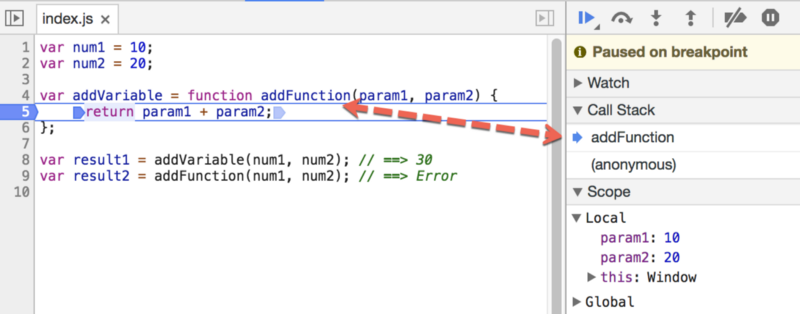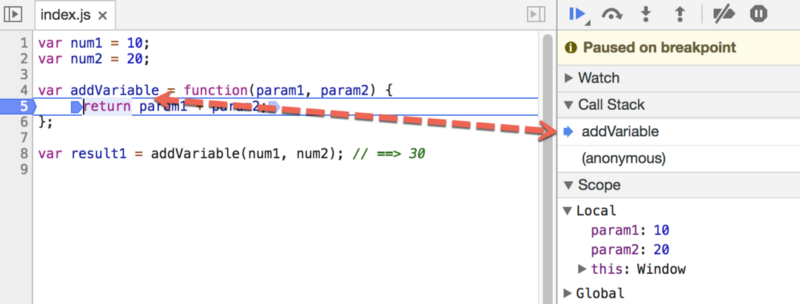(번역) 함수 선언식 vs 함수 표현식
in JavaScript
Ravi Roshan 포스팅 번역
Function Declaration vs Expression
함수 선언식 vs 함수 표현식
- Functions are considered as
First Class citizen in JavaScriptand it is really important to be clear with the concept of creating function in JS.- JS에서 함수는
1급 객체로 간주되므로, 함수 생성의 개념은 아주 중요하다.
- JS에서 함수는

- Unlike other programming languages, we can create function in JavaScript using 3 distinct ways:
- 다른 프로그래밍 언어와는 달리, JS는 3가지 방법으로 함수를 생성할 수 있다.
Function Declaration- 함수 선언식
Function Expression- 함수 표현식
Named Function Expression- named 함수 표현식
Function Declaration
함수 선언식
function [name](param1, param2, ...param3) {
// 함수 Body & Logic
}
- In this case, we prefix
[function keyword]before respective[function name].- 함수 선언식의 경우, 각
[함수 이름]앞에[function 키워드]를 놓는다.
- 함수 선언식의 경우, 각
- One major advantage of this approach is that the complete function is Hoisted.
- 함수 선언식의 큰 장점은, 함수가 호이스팅(hoisting)된다는 것이다.
- Because of that, we can execute the function before declaring it.
- 이러한 이유로, 함수를 선언하기 전에 함수를 실행할 수 있다.
- It is helpful when you want to abstract some logic into a function body and the actual implementation will be done at some later point of time.
- 어떤 로직을 함수 body에 추상화하고, 실제 구현이 나중에 수행되기를 원할 때 유용하다.
var num1 = 10;
var num2 = 20;
var result = add(num1, num2); // 30 [선언 전에 실행]
function add(param1, param2) {
return param1 + param2;
}
- Best practice: Always declare the function first and then execute it instead of relying on JavaScript Hoisting.
- 가장 좋은 방법: JS 호이스팅에 의존하는 대신, 항상 함수를 먼저 선언한 후 실행한다.
Function Expression
함수 표현식
- Any statement which assigns some value to some other variable is considered as an Expression.
- 어떤 값을 다른 변수에 할당하는 명령문은 표현식(expression)으로 간주된다.
var a = 100;
var b = 'Hello World';
- In case of Function Expression, a function is created without any name and then assigned to a variable.
- 함수 표현식의 경우, 함수는 이름 없이 생성된 후 변수에 할당된다.
var [name] = function(param1, param2, ...param3) {
// 함수 Body & Logic
}
foo(1, 3, 4);
- Limitation: Function can’t be executed until defined.
- 제약: 함수가 정의될 때까지 실행할 수 없다.
var num1 = 10;
var num2 = 20;
var result = add(num1, num2); // Uncaught TypeError: add is not a function
var add = function(param1, param2) {
return param1 + param2;
}
- The below approach will work.
- 아래 코드는 작동한다.
var num1 = 10;
var num2 = 20;
var add = function(param1, param2) {
return param1 + param2;
}
var result = add(num1, num2); // 30
Named function expressions - Combination of Both Approaches
named 함수 표현식 (두 가지 방식의 결합)
- Now as you understand the differences between the function Declaration vs Expression, let’s explore what happens when we mix both of them.
- 함수 선언식과 함수 표현식의 차이를 이해했으니, 이 두 가지를 섞었을 때 어떻게 작동하는지 살펴보자.
var num1 = 10;
var num2 = 20;
var addVariable = function addFunction(param1, param2) {
return param1 + param2;
}
- Pay close attention to the fact that the function is
NOTanonymous anymore and having a name asaddFunction.- 함수가 더 이상 익명이
아닌사실에 주의한다. addFunction이라는 이름을 가진다.
- 함수가 더 이상 익명이
- Also, it is assigned to a variable
addVariable.- 또한,
addVariable변수에 할당된다.
- 또한,
- Now just because you have appended a name to function keyword, that doesn’t mean that it can be executed by that name.
- function 키워드에 이름을 추가했지만, 해당 이름으로 실행될 수 있는 것은 아니다.
var result = addFunction(num1, num2); // Uncaught ReferenceError: addFunction is not defined
- Rather, only the assigned variable name
addVariablecan be used to refer & execute it.- 할당된 변수
addVariable만 참조하고 실행할 수 있다.
- 할당된 변수
var result = addVariable(num1, num2); // 30
Important points to consider:
고려해야 할 중요 사항:
addFunctionovershadows theaddVariablein call stack of debugging tools.- 디버깅 도구의 call stack에서
addFunction은addVariable을 덮어버린다.
- 디버깅 도구의 call stack에서
Named 함수 표현식

함수 표현식

- In case of Named function expression, calling
addFunction() outsidethrows error.- named 함수 표현식의 경우,
addFunction() 외부에서 호출하면 에러가 발생한다. Uncaught ReferenceError: addFunction is not defined
- named 함수 표현식의 경우,
- But you can call it from inside the function and that will work.
- 하지만 함수 내부에서 호출하면 작동한다.
var num1 = 10;
var num2 = 20;
var addVariable = function addFunction(param1, param2) {
var res = param1 + param2;
if (res === 30) {
res = addFunction(res, 10);
}
return res;
}
var result = addVariable(num1, num2); // 40
- In this scenario, we are checking if res is 30.
- 위 코드의 경우, res가 30인지 확인한다.
- If so, then calling the same function again by it’s name
addFunctionwith 30 & 10 as parameters which will return 40 as final output.- 30이 맞다면, 동일한 함수를 다시 호출한다.
- 30과 10을 매개변수로 하는
addFunction에 의해, 최종 출력 40을 반환한다.
One serious caveatof using Named function expression in IE8 and below is that it mistakenly creates two completely separate function objects at two completely different times. (Double take)- IE8 이하에서 named 함수 표현식을 사용하는 것에 대한
한 가지 심각한 경고는, 완전히 다른 두 개의 함수 객체를 완전히 다른 시간에 생성한다는 것이다. (Double take)
- IE8 이하에서 named 함수 표현식을 사용하는 것에 대한
- If you need to support IE8, it’s probably best to stick with anonymous function expressions or function declarations, but avoid named function expressions.
- IE8 지원이 필요한 경우, 익명 함수 표현식이나 함수 선언식을 사용하는 것이 가장 좋다.
- named 함수 표현식은 사용하지 않는 것이 좋다.